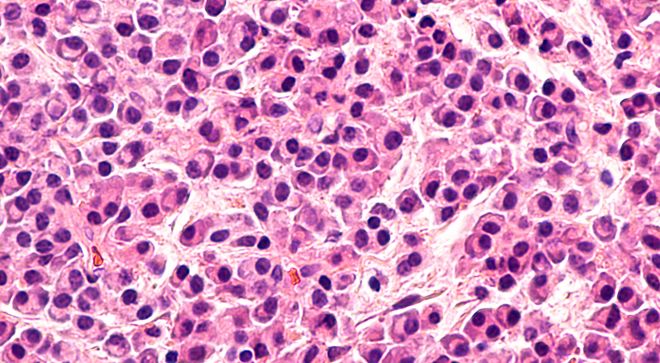News
Article
Multiple Myeloma: 8 Frequently Asked Patient Questions
Questions about multiple myeloma regarding treatment options, bone strength and other associated comorbidities were answered by an expert.
Dr. Brandon Blue answered frequently asked questions about multiple myeloma.

Multiple myeloma is a rarer disease than other cancers, such as lung or breast cancer, an expert told CURE®. During the CURE® Educated Patient® Multiple Myeloma Summit, patients asked some questions about the disease.
CURE® sat down with Dr. Brandon Blue to answer frequently asked questions about treatment options, bone strength and other comorbidities associated with multiple myeloma. Blue is an assistant member of malignant hematology at Moffitt Cancer Center in Tampa, Florida and chair of the multiple myeloma summit.
For relapsed myeloma (cancer that has returned), what is typically the recommended order of treatment options?
Blue: Multiple myeloma has a lot of different options. Typically, when someone is newly diagnosed, that's the preferred time that patients actually get the stem cell transplant. This is because the stem cell transplant is typically not recommended in what we call the relapse setting.
At the initial diagnosis stage, patients get their disease under control with a three- or four-drug regimen, and then they move to step two, which is the stem cell transplant that leads them into a long remission. After the remission is over, meaning that the disease has now relapsed, now you're on to these new therapies. Depending on exactly how your disease has relapsed will depend on what that next line will be.
For example, there are some patients who, after their remission, their disease is going up so slowly, so we have plenty of time to think about what the best next step should be. On the other side, there are some patients who come out of remission and their disease shoots up like a rocket and moves so fast. So we have to be very strategic about what we're doing because literally, days matter. So again, that's something that is very specific to your type of disease.
If I’m on a three-drug regimen, should I be concerned that I am not on a four-drug regimen?
One of the things that is very important with multiple myeloma is that there are so many different treatment options. Because there are so many different options, what we can do as the providers, is to actually hand pick a specific regimen that works best for you as a patient. So you say, “What does that mean, Dr. Blue?”
If you look at the person who's literally right next to you, they could have the same multiple myeloma diagnosis but be on different medications. And so, there are certain reasons that your doctor may choose and say, “You know what, I think based on your specific case, drugs A and B might actually work best for you, as opposed to someone literally with the same diagnosis, drug C and D would work best for them.”
I think it's all a conversation, and I think there may be some nuanced reasons why your doctor chose those regimens. I would just say, have a conversation with your provider and just try to make sure that if there are questions about why they chose those certain medicines. Typically, there is a reason. So you want to just have that conversation and be open.
What is a tandem transplant? Are there situations where you do tandem transplants?
Sometimes what happens is that once the disease is at its very newly diagnosed state, when there's so much cancer there, we try to get the disease under control, and then the next step would be to move to what they call a stem cell transplant.
However, some data shows that there are some patients who not only get one transplant, but then turn around and get a second transplant right after that's called a tandem, meaning to get the disease under control, patients receive transplant one, followed by transplant two. There are some very unique circumstances that are being done, but I will tell you that as of 2024, it's becoming less and less common.
After multiple myeloma, will my bones ever strengthen back to normal again?
Unfortunately, up to 80% of people who have a diagnosis of multiple myeloma have some type of bone disease. What happens is that the bone damage happens actually from active cancer. Once you start therapy, the good news is that the cancer is now out of those bones. And unfortunately, a lot of those bones just never heal, even though there's no more damage being done.
Unfortunately, the damage sometimes is just irreversible. However, we do try to strengthen the bones by giving certain medications that your doctor can talk to you about. But sometimes the bones just never get back to their pre-cancer state.
What is the most effective way to manage bone pain in multiple myeloma?
Pain is one of those things that's so subjective. For example, some people have bone disease, but they walk around and say, “Hey, Dr. Blue, I feel fine.” And then other people, unfortunately, have less bone disease, but they are in a wheelchair.
One thing to know about multiple myeloma is the average age of diagnosis is 69, so most of the patients who have this disease are older or are in the older population, and so what we know is that not everyone's biological age is really the same. For example, for some people who are 70 years old, unfortunately, their bodies may have certain what we call comorbidities or other health issues that may make them seem like a 75 or 80-year-old, as opposed to some people who are 70 and you're like, “Oh my gosh, this person has the body of a 60-year-old.” So again, they can be very complicated, but I will say that there are a lot of nuances to that answer.
How soon should a bone marrow biopsy be conducted after a transplant?
Each institution that does stem cell transplants has its own protocol, but most places do it somewhere around the three-month mark. That's typically where you don't want to do it too early because we know that stem cell transplant can really wipe out the bone marrow.
But you don't want to do it too late, because typically the next step after transplant is maintenance, and you want to get back on maintenance within a three- to six-month period. So typically, around that three-month area is when most places do the bone marrow biopsy after transplant.
Is there a connection to an atrial fibrillation diagnosis after receiving a diagnosis of multiple myeloma?
Yes, unfortunately, atrial fibrillation happens when the heart is stressed. There are a lot of reasons for your heart to be stressed when patients have a diagnosis of multiple myeloma. For example, one of the main kind of complications of multiple myeloma is people developing low blood counts or something called anemia.
When you have anemia, that means that there's basically less red blood cells circulating in your body. Well, guess what? If the heart is a pump that's supposed to pump blood, but there are less red blood cells, that means that the pump has to just work harder and harder. And like any good muscle, it just gets stressed if you work it too hard. So there is an increased association there.
Also, certain chemotherapy medicines put more stress on the heart. Anything that can really put stress on the heart really can increase the risk for atrial fibrillation.
Can you be eligible for CAR-T cell therapy if you’re in renal failure?
Renal failure is not an exclusion for patients to get CAR-T cell therapy, so we do it for patients. So sometimes when patients’ kidneys don't work, they need something called dialysis, which is a machine that can filter the blood, which is the same role that the kidneys would do. It's just this time, it's a machine that does it for them. And so, we have patients who are actually on dialysis, who still receive CAR-T cell therapy.
For more news on cancer updates, research and education, don’t forget to subscribe to CURE®’s newsletters here.




